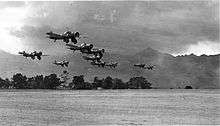Curtiss A-12 Shrike
The Curtiss A-12 Shrike was the United States Army Air Corps' second monoplane ground-attack aircraft, and its main attack aircraft through most of the 1930s. It was based on the A-8, but had a radial engine instead of the A-8's inline, water-cooled engine, as well as other changes.
| A-12 Shrike | |
|---|---|
.jpg) | |
| Role | Ground-attack aircraft |
| Manufacturer | Curtiss |
| Introduction | 1933 |
| Retired | 1942 |
| Primary users | United States Army Air Corps Nationalist Chinese Air Force |
| Number built | 46[1] |
| Unit cost |
US$19,483 |
| Developed from | XA-8 Shrike YA-10 Shrike |
Design and development

The Model 60 was developed from advancements of the A-8 and the experimental YA-10. However, it became obsolete after a short use period, mainly because of fast-improving aviation technology, as well as the USAAC's desire for multi-engined attack aircraft.[2]
The most obvious difference between the A-12 and the A-8 is the air-cooled, radial engine in the A-12, which replaced the A-8's inline, water-cooled engine. This was a response to the USAAC's move toward a preference for radial engines, especially in attack aircraft. The rationale behind this preference is that the radial engine has a lower profile, making it less vulnerable to ground fire, and a simpler cooling mechanism, which is also less prone to groundfire, as well as overall maintenance problems.[2]
These aircraft retained the open cockpit introduced in the A-8 production batch, and carried the same weapons load. In an attempt to improve pilot/observer co-operation, the rear cockpit was moved forward sufficiently for its glazed covering to form a continuation of the fuselage decking behind the pilot's cockpit.[3]
Nine USAAF A-12s were still in service at Hickam Field on 7 December 1941, but they saw no combat.[4]
Serial numbers: 33-212/257
Operational history
A-12s served with the 3rd Attack Group plus the 8th and 18th Pursuit Groups. Surviving Shrikes were grounded just after Pearl Harbor was bombed in December 1941.[5]
Operators

- Chinese Nationalist Air Force received 20 A-12 Shrikes in 1936, arming the 27th and the 28th Squadron of the 9th Group. When full-scale war broke out between Japan and China, they were used. The initial success including the downing of four Japanese Aichi D1A1 carrier-based dive bombers on 15 August 1937. However, after deploying in ground support missions in Shanxi, most did not survive and the few left were reassigned to training duties.[2]
Specifications (A-12 Shrike)
Data from Curtiss Aircraft 1907–1947,[6] The Complete Encyclopedia of World Aircraft[4]
General characteristics
- Crew: 2
- Length: 32 ft 3 in (9.83 m)
- Wingspan: 44 ft 0 in (13.41 m)
- Height: 9 ft 0 in (2.74 m)
- Wing area: 284 sq ft (26.4 m2)
- Empty weight: 3,898 lb (1,768 kg)
- Gross weight: 5,756 lb (2,611 kg)
- Powerplant: × Wright R-1820-21 Cyclone 9-cylinder air-cooled radial piston engine, 690 hp (510 kW)
- Propellers: 3-bladed fixed-pitch propeller
Performance
- Maximum speed: 176.7 mph (284.4 km/h, 153.5 kn)
- Cruise speed: 151 mph (243 km/h, 131 kn)
- Range: 521 mi (838 km, 453 nmi)
- Service ceiling: 15,150 ft (4,620 m)
- Rate of climb: 1,170 ft/min (5.9 m/s)
Armament
- Guns:
- 4 × forward-firing 0.300 in (7.6 mm) M1919 Browning machine guns mounted in the wheel fairings
- 1 × 0.300 in (7.6 mm) machine gun mounted in the observer's cockpit for rear defense
See also
Related development
Aircraft of comparable role, configuration and era
Related lists
References
- Notes
- Fahey, James C. U.S. Army Aircraft 1908–1946. New York: Ships and Aircraft, 1946.
- "Curtiss A-12." National Museum of the United States Air Force. Retrieved: 7 July 2017.
- Swanborough, F. G. and Peter M. Bowers. United States Military Aircraft Since 1909. New York: Putnam, 1964. ISBN 0-85177-816-X.
- Eden and Moeng 2002, p. 514.
- Fitzsimons 1969, p. 2324.
- Bowers, Peter M. (1979). Curtiss aircraft, 1907–1947. London: Putnam. pp. 327–331. ISBN 0370100298.
- Bibliography
- Eden, Paul and Soph Moeng, eds. The Complete Encyclopedia of World Aircraft. London: Amber Books Ltd., 2002, ISBN 0-7607-3432-1.
- Fitzsimons, Bernard, ed. The Illustrated Encyclopedia of the 20th Century Weapons and Warfare, Vol. 21. London: Purnell & Sons Ltd., 1969, First edition 1967. ISBN 0-8393-6175-0.
- Andrade, John M. . U.S Military Aircraft Designations and Serials since 1909. Leicester: Midland Counties Publications, 1979. ISBN 0-904597-22-9.
- Swanborough, F. G. and Peter M. Bowers. United States Military aircraft since 1909. London: Putnam, 1963, 1971, 1989. ISBN 0-85177-816-X.
- Bowers, Peter M. . Curtiss Aircraft 1907-1947. London: Putnam, 1979, 1987. ISBN 0-8517-7811-9.
External links
| Wikimedia Commons has media related to Curtiss A-12 Shrike. |